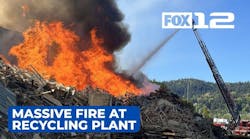Nearly 40% of the state is still in commercial forestland. Its pine barrens, located in the southern part of the state, contain over 1 million acres of highly combustible trees and brush. Another 13% is in parks, recreation areas and watersheds. Numerous farms, orchards and gardens are scattered throughout the state.
Adequate protection from wildfire is essential. The value of forest resources is estimated at $8.5 billion dollars. The wood industry alone employs 33,000 people with an annual payroll of $1 billion. Water quality, animal habitat, recreation and the ever-expanding structural wildland interzone (SWI) areas demand fire protection resources.
In 1899, a consultant submitted a report to the state that emphasized the need for forest fire control and the establishment of a forest fire service. In 1906, a law was passed establishing the New Jersey Forest Fire Service (NJFFS). A fire warden system was formed with 64 wardens appointed within the first year. In 1910, a system of forest fire watchtowers was begun.
It was not until 1924 that the present system of forest fire protection was organized. In 1927, the first aircraft was used for aerial fire observation. The CCC constructed a series of firebreaks and roads in New Jersey forests and parks from 1933 to 1942.
Rapid advancements and improvements in motorized "track" vehicles and communications occurred from the 1930s through the 1950s. In 1961, aircraft was first utilized for aerial water bombing of fires. A reorganization and professionalization of the NJFFS was begun in 1978 and completed in 1980.
|
Today's Forest Fire Service
The NJFFS is part of the state Department of Environmental Protection's Division of Parks and Forests. The forest fire service has 75 full-time employees augmented by a large part-time/seasonal fire suppression force to handle forest fire problems and other related functions. The service is under the direction of a state fire warden with a permanent staff located in the Trenton headquarters.
The service is responsible for protecting 3.15 million acres of both public and private lands statewide. The areas are divided into three divisions - north, south and central.
A division forest fire warden administers each division. Each division is further partitioned into 100,000-acre sections. A full-time forest fire warden is assigned to each section. Sections are each subdivided into districts of 15,000 to 20,000 acres and a district forest fire warden is appointed. That warden is responsible for recruiting and training fire crews and issuing fire permits, fire suppression and other related jobs.
There are 249 district forest fire wardens statewide and more than 1,000 trained crew personnel listed in the state action and resource plans.
The NJFFS maintains a fleet of 246 fire suppression and other vehicles, 24 dozer/plow units, six aircraft and 138 pieces of specialized equipment. The service builds its initial-attack vehicles consisting of a truck cab, four-by-four chassis, utility body, 250-gallon water tank, pump, plumbing and special reinforcing bars. The service also converts and modifies federal excess property military vehicles into specialized firefighting equipment.
When a wildfire occurs, the first step in the process is a timely and accurate reporting of the fire's location. To accomplish this, the service maintains a system of 21 fire observation towers at strategic locations throughout the state. These towers are usually staffed whenever it is dry enough to burn and during the months of March, April, May, October and November. The tower observers detect half of all wildfires reported.
The forest fire observers do the initial dispatching of equipment. The respective division office does subsequent dispatching. The section forest fire warden forms the initial attack force and serves as the incident commander (IC). Aircraft are automatically dispatched when air attack bases are operational. The state contracts 10 additional fixed wing aircraft for aerial operations.
NJFFS personnel perform the initial fire attack on most wildland fires, other than in highly urbanized areas. The first-in fire unit begins size-up and fire attack. The section or district fire warden, in most cases, performs these functions and may request additional resources through the division office. Depending on the extent of the fire, weather conditions, structural protection if needed and other factors, the local fire department(s) may also be dispatched.
When a wildfire reaches 50 acres in size, it is reported to the division and the state headquarters. When a fire reaches or exceeds 100 acres, an incident command post is established and an observation aircraft is dispatched to aid in control and command operations. Additional state personnel and equipment can be moved from different areas to assist at large fires through the state headquarters. Should the need arise, the NJFFS can request assistance from the U.S. Forest Service and the Middle Atlantic Forest Fire Compact.
The forest fire service sponsors several programs designed to provide assistance to communities in time of need. Basic wildfire suppression and wildland/urban interface fire tactics training is provided to volunteer fire companies in all counties. Help is also provided under two federal programs:
Rural Community Fire Protection (RCFP) - Provides up to 50/50 cost-share grants to communities under 10,000 population to purchase pumps, fire suppression equipment and other items to improve rural community fire protection.
Federal Excess Property Program (FEPP) - Distributes federal excess military vehicles to volunteer fire companies for conversion into fire suppression vehicles.
In 1985, the service signed a cooperative agreement with the U.S. Forest Service for out-of-state travel to large wildland fires. NJFFS personnel have been sent out to many states across the country during periods of national fire mobilization. In addition, the service has assisted communities and other agencies throughout New Jersey during other emergencies including: coastal storms, floods, search and rescue missions, and other emergencies.
The service conducts an extensive fire prevention and education program for the public. The goals are to reduce the number of fire starts and lessen the severity of the problem. These programs are presented at schools, shopping centers, parades and social clubs, as well as at meetings of Boy Scouts, Girl Scouts and other organizations. Articles and pamphlets outlining special fire problems and situations are published and distributed.
Hazard reduction is a major feature of the prevention program:
- Prescribed burning operations have been conducted on state lands since 1936. An average of 10,000 to 15,000 acres are treated (burned) annually.
- The service's "Fireline Program" maintains hundreds of miles of firelines and firebreaks to provide access and break up large, unbroken forest areas.
The service's law enforcement program begins with a basic investigation to determine a fire's cause. Incendiary/arson fires account for 46.1% of all wildfires in New Jersey. The service may assess the cost of fire extinguishment, impose fines or recommend jail terms. An average of 150 violations and subsequent actions are recorded annually. The mission of the NJFFS is to "assist the residents of New Jersey in preserving, sustaining, protecting and enhancing the environment to ensure the integration of high environmental quality, public health and economic vitality…"
For additional information contact the New Jersey Forest Fire Service at the state headquarters located at 501 E. State St., CN 404, Trenton, NJ 08625. Telephone: 609-292-2977. Fax: 609-984-0378.
Robert M. Winston, a Firehouse® contributing editor, is a district fire chief in the Boston Fire Department with extensive experience and training in wildland and SWI protection. Questions and comments may be sent to him via e-mail at [email protected]









